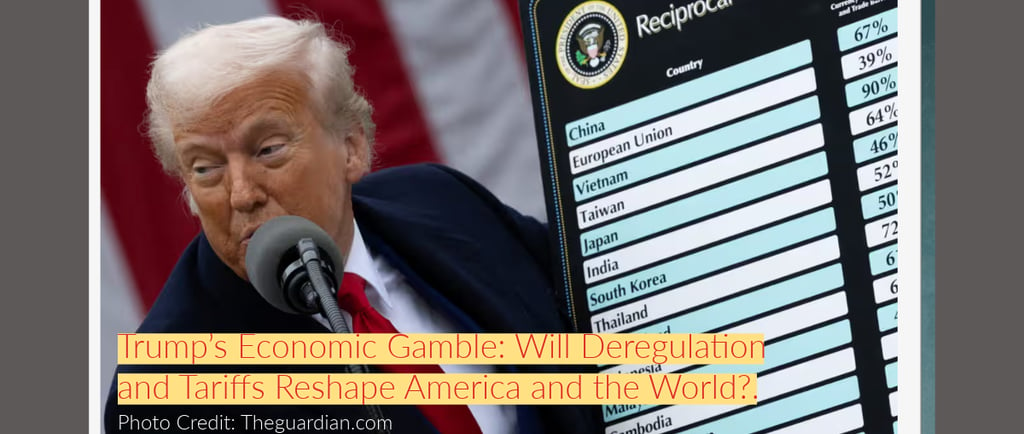Trump’s Economic Gamble: Will Deregulation and Tariffs Reshape America and the World?
4/16/2025


Trump’s Economic Gamble: Will Deregulation and Tariffs Reshape America and the World?
In April 2025, President Donald Trump’s second term is shaking up the global economy with bold moves: sweeping deregulation to unleash American businesses and aggressive tariffs to bring manufacturing home. These policies promise an “America First” renaissance but come with risks—higher prices, trade wars, and market turmoil. As the U.S. stock market swings and global partners brace for impact, the world watches to see if Trump’s gamble will pay off or backfire. Here’s how deregulation and tariffs are reshaping U.S. and global markets, and what they mean for inflation, trade, and your wallet.
Deregulation: Unleashing Growth or Courting Risk?
Trump’s deregulation agenda is a turbocharger for American industry. By slashing red tape in energy, finance, and manufacturing, he aims to cut costs and boost production. Think cheaper oil and gas, more drilling, and fewer hoops for banks. In the U.S., energy and banking stocks have surged, with investors betting on higher profits. The White House claims these moves could lower fuel prices, easing inflation (currently 2.5% core PCE) and powering growth.
But there’s a catch. Loosening environmental rules could spark long-term costs from climate damage, while lighter financial oversight raises fears of another 2008-style crisis. Globally, increased U.S. oil output might cool energy prices, but it’s a double-edged sword for producers like Saudi Arabia. Will deregulation fuel a lasting boom, or are we trading short-term gains for bigger risks?
Tariffs: A Manufacturing Dream or a Consumer Nightmare?
Trump’s tariff blitz is the headline-grabber. Starting April 5, 2025, a 10% tariff hits most U.S. imports, with steeper duties—up to 54% on China—targeting trade deficits. Covering $2.4 trillion in goods, these tariffs aim to revive U.S. factories and shrink the $1.2 trillion trade gap. Trump argues they’ll bring jobs home, pointing to steel gains from his first term.
Yet, the fallout is immediate. U.S. consumers face higher prices for everything from iPhones to jeans—an estimated $1,300 extra per household in 2025, per the Tax Foundation. Inflation could hit 3.5%, pressuring the Federal Reserve to rethink rate cuts. Markets tanked, with the Dow dropping 4% and Apple shares sliding 9%. Globally, export-heavy nations like Vietnam and Bangladesh face economic havoc, while China, Canada, and the EU retaliate, targeting $330 billion in U.S. exports like Boeing planes.
The Penn Wharton Budget Model warns of a 6–8% GDP hit long-term, with J.P. Morgan pegging a 60% chance of global recession. But Trump’s team sees tariffs as leverage, forcing trade partners to negotiate. Will this spark a manufacturing revival, or are we headed for stagflation and a fractured global economy?
The Bigger Picture: Boom, Bust, or Bargaining Chip?
Trump’s policies are a high-stakes bet. Deregulation could lower costs and boost energy independence, but reckless cuts risk systemic failures. Tariffs might reshore jobs but threaten consumers and global trade. The U.S., absorbing 13% of global imports, isn’t irreplaceable—China and others are already eyeing new markets. Allies like Japan and Canada, hit with 24% and 25% tariffs, are rethinking partnerships, while the IMF warns global growth could dip below 2%, the weakest since 2008.
Yet, Trump thrives on disruption. Tariffs could be a negotiation tactic, pressuring nations to cut deals on trade, migration, or security. Early talks with Vietnam suggest some flexibility, but broad tariffs risk a trade war that isolates the U.S. The dollar’s global role is under scrutiny, and markets fear policy unpredictability could spark deeper instability.
What’s at Stake for You?
For Americans, it’s a mixed bag. Lower energy costs and potential job growth are upsides, but higher prices and economic slowdown loom. Globally, supply chains are scrambling, and developing nations face export crunches. As Trump doubles down, the world braces for a reshaped economic order—one that could either strengthen America’s hand or fragment the global system.
Thought-Provoking Questions:
Can Trump’s tariffs bring back manufacturing without crushing consumers?
Is deregulation a smart way to boost growth, or are we risking long-term stability?
How will global retaliation shape America’s role in trade and geopolitics?
hello@boncopia.com
+13286036419
© 2025. All rights reserved.